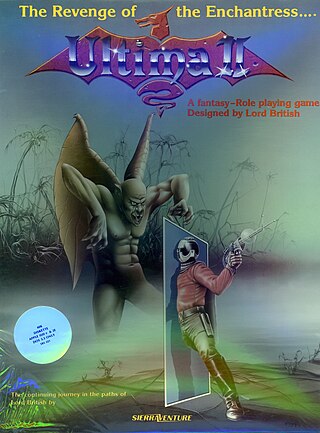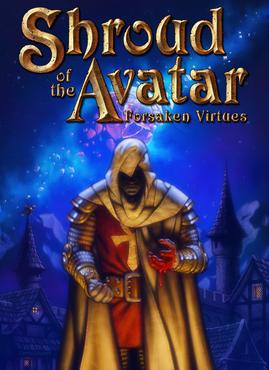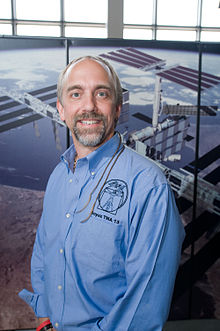
Ultima is a series of open world fantasy role-playing video games from Origin Systems, created by Richard Garriott. Electronic Arts has owned the brand since 1992. The series had sold over 2 million copies by 1997.

Lunokhod 2 was the second of two uncrewed lunar rovers that landed on the Moon by the Soviet Union as part of the Lunokhod programme.
Lord British, or Lord Cantabrigian British, is the fictional ruler of Britannia, a kingdom in the fictional world of Sosaria, created by Richard Garriott for his video game series Ultima.

Origin Systems, Inc. was an American video game developer based in Austin, Texas. It was founded on March 3, 1983, by Richard Garriott and his brother Robert. Origin is best known for their groundbreaking work in multiple genres of video games, such as the Ultima and Wing Commander series. The company was purchased by Electronic Arts in 1992.

Tracy Raye Hickman is an American fantasy author and designer of games and virtual reality (VR) experiences. He co-authored the original Dragonlance novels with Margaret Weis as well as numerous other books. He also designed and created role playing game material while working for TSR and has cowritten novels with his wife, Laura Hickman. He is the author or co-author of over 60 books.

Edward Michael "Mike" Fincke is an American astronaut who formerly held the American record for the most time in space. His record was broken by Scott Kelly on October 16, 2015.
Scott Jennings, also known as Lum the Mad, is an American commentator on MMORPG games. He is best known for creating a website, The Rantings of Lum The Mad, a pioneer blog, which existed from 1998 to 2001, when Jennings was hired by MMO developer Mythic Entertainment, where he remained until 2006.

Ultima II: The Revenge of the Enchantress, released on August 24, 1982, for the Apple II, is the second role-playing video game in the Ultima series, and the second installment in Ultima's "Age of Darkness" trilogy.

Ultima IV: Quest of the Avatar, first released in 1985 for the Apple II, is the fourth in the series of Ultima role-playing video games. It is the first in the "Age of Enlightenment" trilogy, shifting the series from the hack and slash, dungeon crawl gameplay of its "Age of Darkness" predecessors towards an ethically nuanced, story-driven approach. Ultima IV has a much larger game world than its predecessors, with an overworld map sixteen times the size of Ultima III and puzzle-filled dungeon rooms to explore. Ultima IV further advances the franchise with dialog improvements, new means of travel and exploration, and world interactivity.

Ultima VII: The Black Gate is the seventh installment of the Ultima series of role-playing video games, released in April 1992. In it, the player returns as The Avatar, a would-be paragon of moral virtue who faces down many dangers and deceptions in order to cleanse the medieval fantasy world of Britannia of assorted plots and schemes, monster infestations, and the undermining of crown authority.

Ultima IX: Ascension is a 1999 role-playing video game developed by Origin Systems and published by Electronic Arts for Microsoft Windows. It is the ninth and final main installment of the Ultima series.
Robert K. Garriott is an American video game industry figure and entrepreneur. He co-founded Origin Systems and Destination Games with his brother, Richard Garriott, and was the CEO of NCsoft-North America from 2001 until 2008. He is the second-eldest son of NASA astronaut Owen K. Garriott.

Soyuz TMA-12 was a Soyuz mission to the International Space Station (ISS) which was launched by a Soyuz FG rocket at 11:16 UTC on 8 April 2008. It docked to the Pirs module of the station on 10 April 2008. Landing occurred at 03:37 on 24 October. It was the first nominal landing in three missions, following separation failures on the Soyuz TMA-10 and 11 spacecraft.

Gregory Errol Chamitoff is a Canadian-born American engineer and former NASA astronaut. He has been to space twice, spending 6 months aboard the ISS across Expedition 17 and 18 in 2008, and another 15 days as part of STS-134 in 2011. STS-134 was the last of Space Shuttle Endeavour which delivered the Alpha Magnetic Spectrometer and completed the US Orbital Segment.

Windows on Earth is a museum exhibit, website, and exploration tool, developed by TERC, Inc., and the Association of Space Explorers, that enables the public to explore an interactive, virtual view of Earth from space. In addition, the tool has been selected by NASA to help astronauts identify targets for photography from the International Space Station (ISS).

Apogee of Fear is a 2012 science fiction comedy short film, the first narrative fiction film made completely in space. Filmed by Richard Garriott from a script and production elements he contracted from fantasy novelist Tracy Hickman, the film's principal photography was accomplished during Garriott's time aboard the International Space Station as a spaceflight participant in October 2008.

Portalarium, Inc. was a video game developer based in Austin, Texas that was formed in September 2009 by Richard Garriott, together with his longtime game industry partners, Dallas Snell and Fred Schmidt. Portalarium marks Richard Garriott's first return to the video game industry since the release of his 2007 title Tabula Rasa. The name "Portalarium," as well as the company's motto, "We take you there," are intended as a continuity and reference to Garriott's prior two companies' names and respective mottoes; Origin Systems, "We Create Worlds," and Destination Games, "We have arrived."

Shroud of the Avatar: Forsaken Virtues is a fantasy role-playing video game. Described as being a spiritual successor to the Ultima series, Shroud of the Avatar was developed by Austin, Texas-based developer Portalarium, with a team led by Richard Garriott as creative director, Starr Long as executive producer, Chris Spears as lead technical designer, and Tracy Hickman as lead story designer. It is currently maintained by Catnip Games.

Starr McAuley Long is an American game developer, a long time collaborator with Richard Garriott at the companies Origin Systems (1992–2000), Destination Games (2000–2008), and Portalarium (2013–present). In 1997, Long was the original director of the early graphical multiplayer game Ultima Online, and from 2008–2013 he was executive producer at The Walt Disney Company, where he created and managed several educational games and apps for Club Penguin and the Disney Connected Learning platform. In early 2008, he was listed as one of the Top 20 Most Influential People in the MMO industry. In 2013, he again partnered with Garriott at Portalarium, where they began working on a new game Shroud of the Avatar.




















